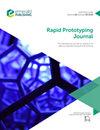Investigation into tensile behavior of 3D printed nylon-based low and high-volume fraction carbon fiber composite
IF 3.6
4区 工程技术
Q1 ENGINEERING, MECHANICAL
引用次数: 0
Abstract
Purpose The tensile behavior of additively manufactured nylon-based carbon fiber-reinforced composites (CFRP) is an important criterion in aerospace and automobile structural design. So, this study aims to evaluate and validate the tensile stiffness of printed CFRP composites (low- and high-volume fraction fiber) using the volume average stiffness (VAS) model in consonance with experimental results. In specific, the tensile characterization of printed laminate composites is studied under the influence of raster orientations and process-induced defects. Design/methodology/approach CFRP composite laminates of low- and high-volume fraction carbon fiber of different raster orientations (0°, ± 45° and 0/90°) were fabricated using the continuous fiber 3D printing technique, and tensile characteristics of laminates were done on a universal testing machine with the crosshead speed of 2 mm/min. The induced fracture surface of laminates due to tensile load was examined using the scanning electron microscopy technique. Findings The VAS model can predict the tensile stiffness of printed CFRP composites with different raster orientations at an average prediction error of 5.94% and 10.58% for low- and high-volume fiber fractions, respectively. The unidirectional CFRP laminate composite with a high-volume fraction (50%) of carbon fiber showed 50.79% more tensile stiffness and 63.12% more tensile strength than the low-volume fraction (26%) unidirectional composite. Fiber pullout, fiber fracture and ply delamination are the major failure appearances observed in fracture surfaces of laminates under tensile load using scanning electron microscopy. Originality/value This investigation demonstrates the novel methodology to study specific tensile characteristics of low- and high-volume fraction 3D printed CFRP composite.三维打印尼龙基低体积分数碳纤维复合材料的拉伸性能研究
目的添加制造的尼龙基碳纤维增强复合材料(CFRP)的拉伸性能是航空航天和汽车结构设计中的一个重要标准。因此,本研究旨在使用体积平均刚度(VAS)模型评估和验证印刷CFRP复合材料(低和高体积分数纤维)的拉伸刚度,并与实验结果相一致。具体而言,研究了光栅取向和工艺缺陷影响下印刷层压板复合材料的拉伸性能。设计/方法/方法采用连续纤维3D打印技术制备了不同光栅方向(0°、±45°和0/90°)的低和高体积分数碳纤维CFRP复合材料层压板,并在十字头速度为2的万能试验机上对层压板的拉伸特性进行了研究 mm/分钟。利用扫描电子显微镜技术研究了层压板在拉伸载荷作用下的诱导断裂表面。结果VAS模型可以预测具有不同光栅方向的印刷CFRP复合材料的拉伸刚度,对于低纤维组分和高纤维组分,平均预测误差分别为5.94%和10.58%。与低体积分数(26%)的单向复合材料相比,具有高体积分数(50%)碳纤维的单向CFRP层压板复合材料显示出50.79%的拉伸刚度和63.12%的拉伸强度。用扫描电子显微镜观察到,在拉伸载荷作用下,层压板的断裂表面主要出现纤维拔出、纤维断裂和层间分层。原创性/价值本研究展示了研究低和高体积分数3D打印CFRP复合材料特定拉伸特性的新方法。
本文章由计算机程序翻译,如有差异,请以英文原文为准。
求助全文
约1分钟内获得全文
求助全文
来源期刊

Rapid Prototyping Journal
工程技术-材料科学:综合
CiteScore
8.30
自引率
10.30%
发文量
137
审稿时长
4.6 months
期刊介绍:
Rapid Prototyping Journal concentrates on development in a manufacturing environment but covers applications in other areas, such as medicine and construction. All papers published in this field are scattered over a wide range of international publications, none of which actually specializes in this particular discipline, this journal is a vital resource for anyone involved in additive manufacturing. It draws together important refereed papers on all aspects of AM from distinguished sources all over the world, to give a truly international perspective on this dynamic and exciting area.
-Benchmarking – certification and qualification in AM-
Mass customisation in AM-
Design for AM-
Materials aspects-
Reviews of processes/applications-
CAD and other software aspects-
Enhancement of existing processes-
Integration with design process-
Management implications-
New AM processes-
Novel applications of AM parts-
AM for tooling-
Medical applications-
Reverse engineering in relation to AM-
Additive & Subtractive hybrid manufacturing-
Industrialisation
 求助内容:
求助内容: 应助结果提醒方式:
应助结果提醒方式:


